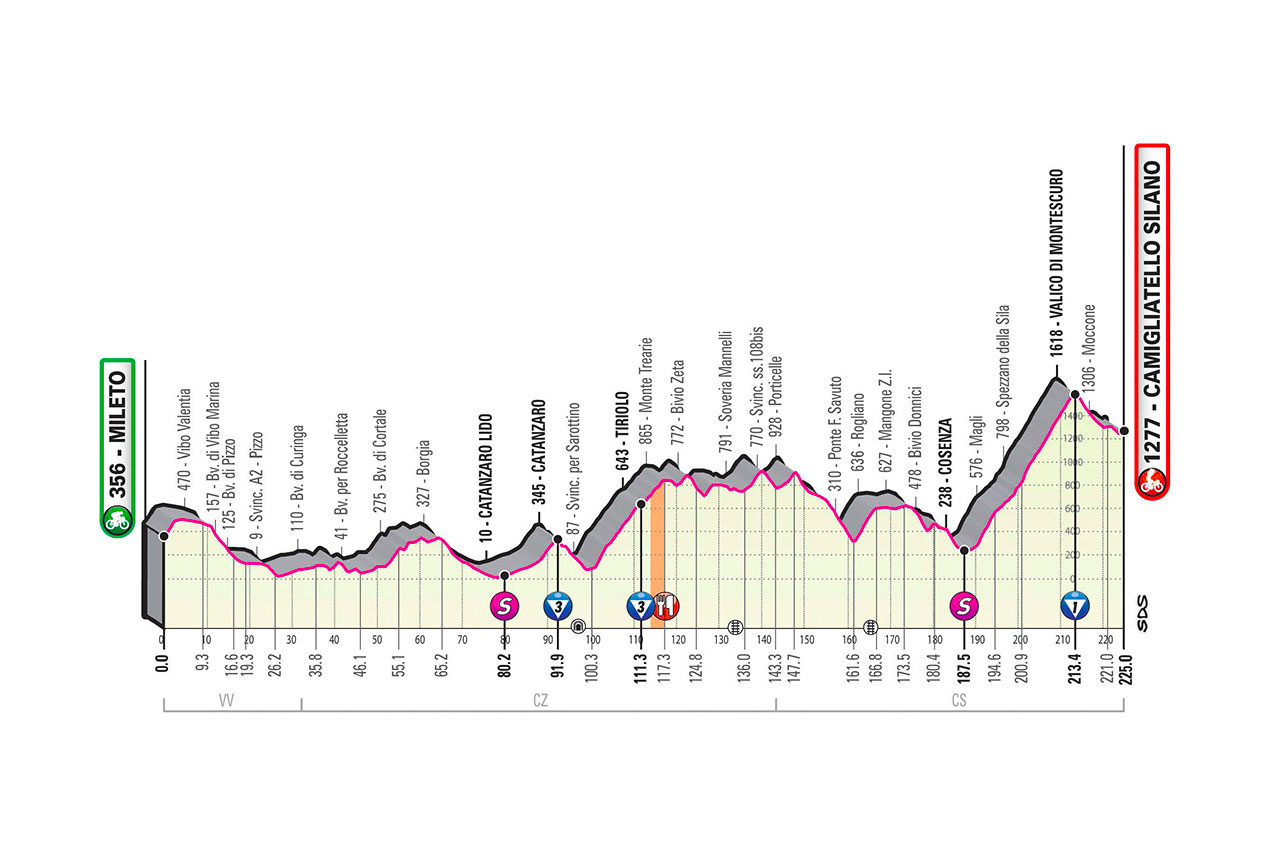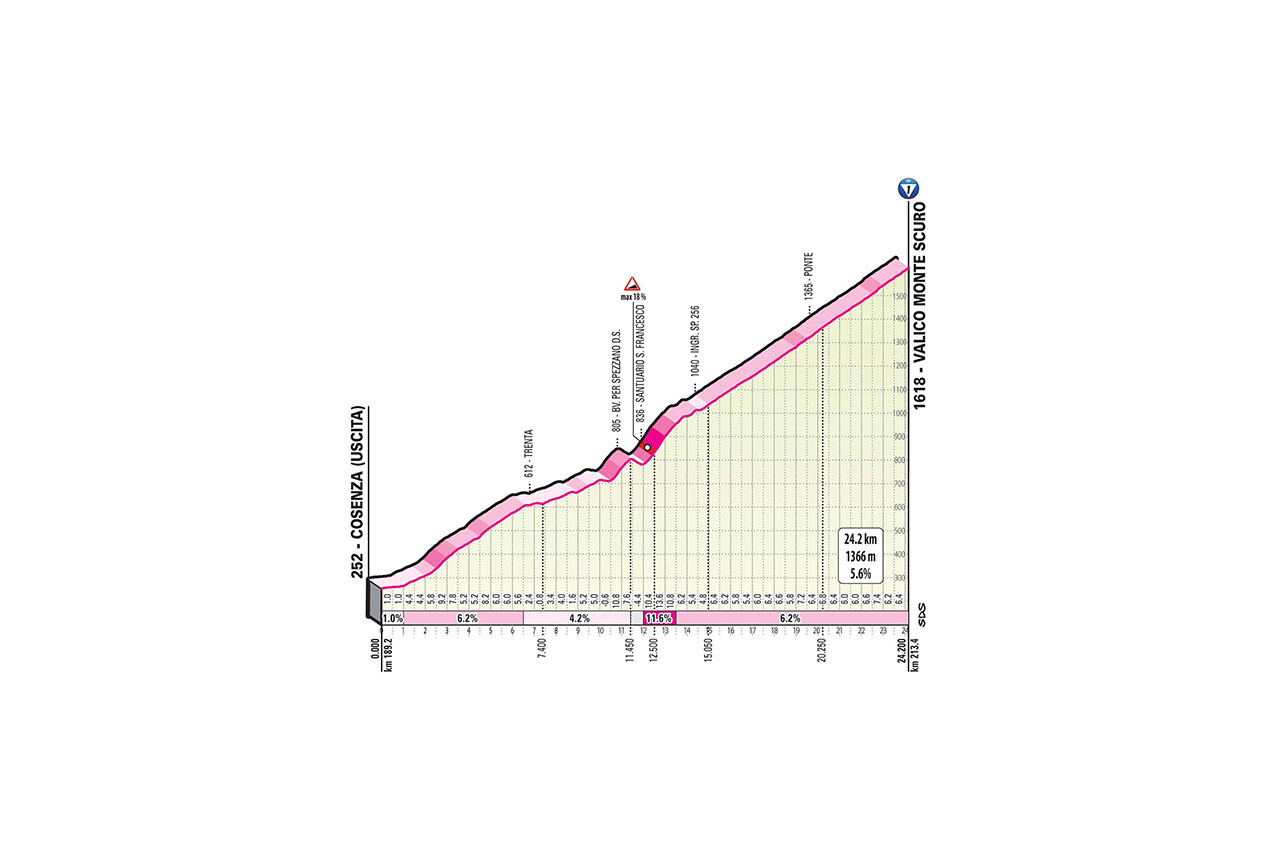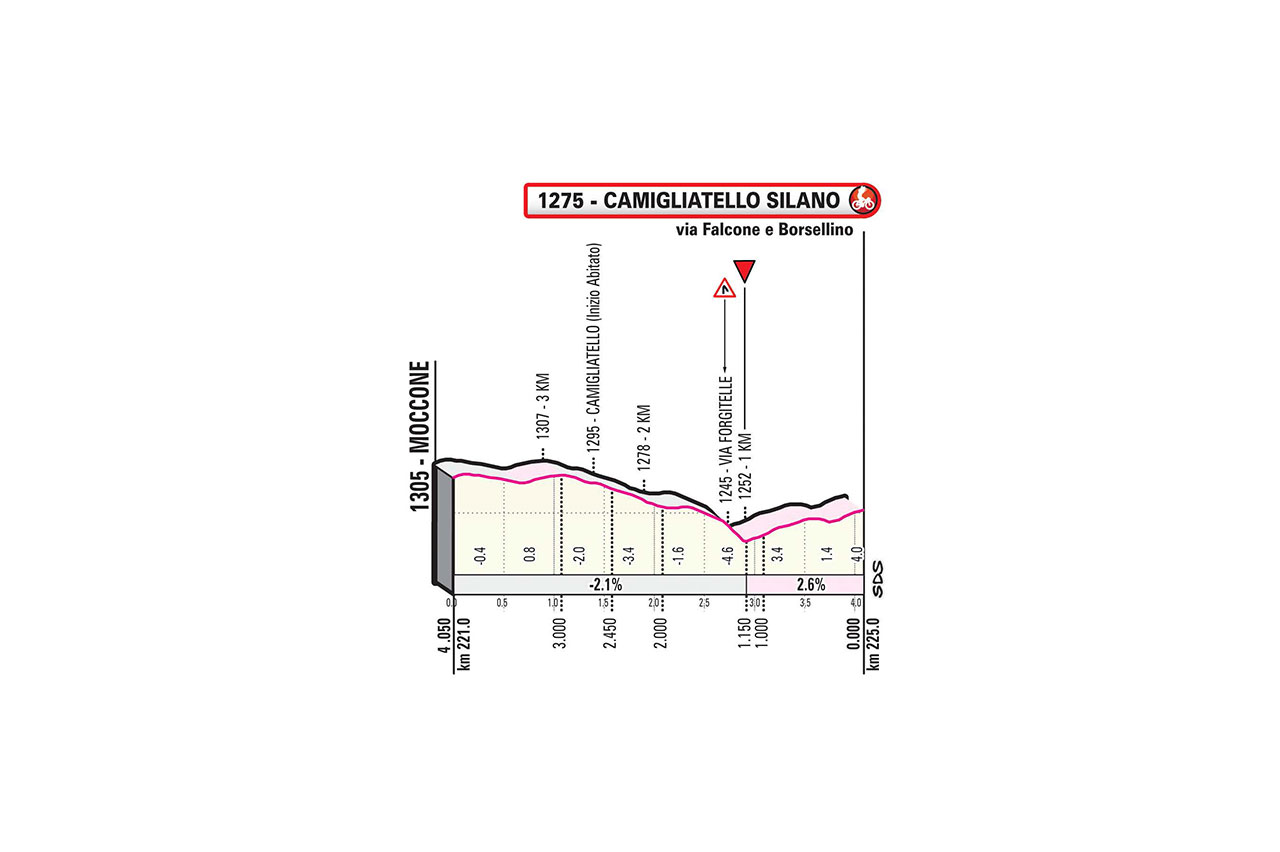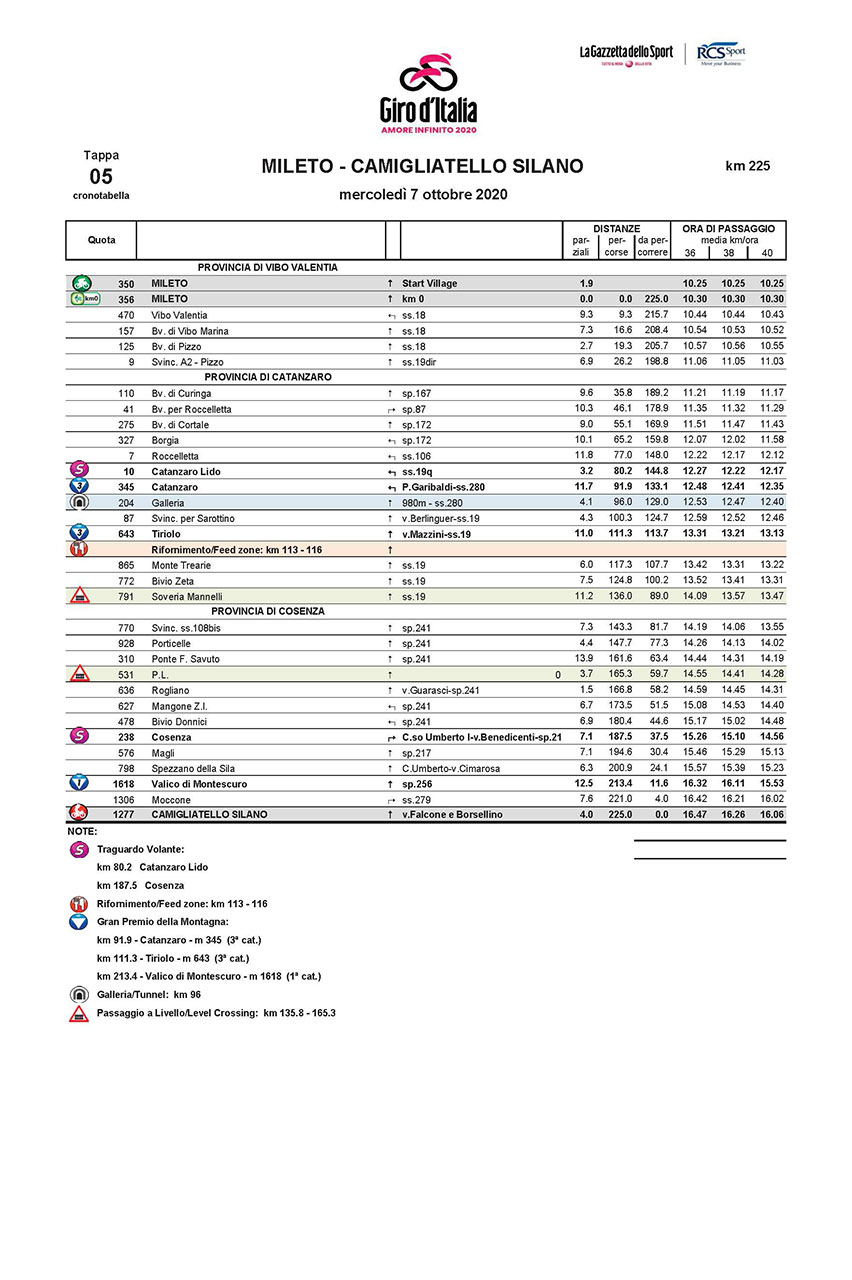profile
map
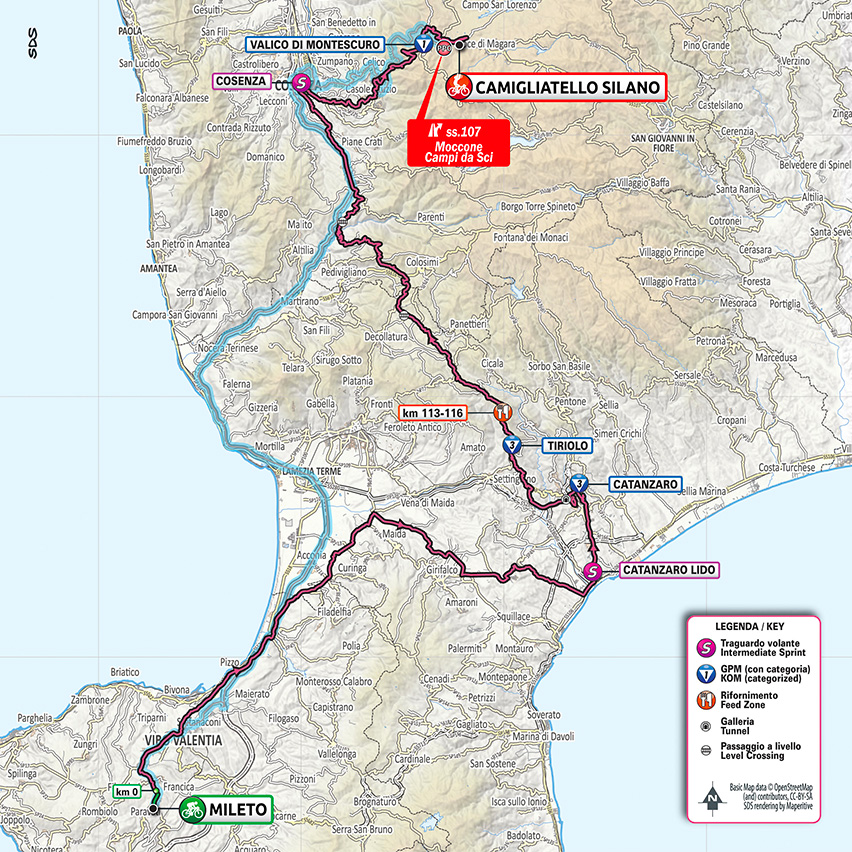
technical info
The Route
The stage has a very wavy profile with several climbs, including three categorised ones. The route briefly heads north along the ss. 18 and travels across Calabria following the winding, bumpy and undulating profile, eventually reaching the Ionian coast. After passing Catanzaro Lido and Catanzaro (categorised climb), and after taking in the Tiriolo climb, the route then undulates continuously for approx. 70 km across the Sila. Past Cosenza, the road starts to go up, heading for Valico di Montescuro. The climb, nearly 25 km in length, has a 5.6% avg. gradient with peaks reaching 18% (in Spezzano della Sila). The road is wide, and ascends in hairpins. Past the Valico, the finish is a little more than 10 km away.
Final kilometres
The road plunges steeply into Moccone (4 km from the finish), then a milder descent leads all the way to Camigliatello. The route crosses part of the urban area (on narrowed roadway at points), then takes a U-shaped bend with 1.2 km to go, heading for the finish. Two wide bends (with approx. 400 m to go) lead into the 6.5 m wide home straight.
start / finish
climb detail
final kilometres
itinerary timetable
tourist info
Host city:
Mileto
Overview
Mileto is a recently founded city. In 1784, the engineers A. Winspeare and L. La Vega and the architect V. Ferraresi signed its project. The urban planning of the new Mileto is rectangular, with lengthwise streets, intersected with perpendicular ones. Four symmetrical squares were provided for daily markets and a wider central square for special ones.
Its practical realization maintained the original project. Therefore, the so-called Old Town of the actual city almost echoes the original planning. The only significant change is the public garden which replaces the central square.
Mileto citizens reaped the ruins of the abandoned Norman city, in order to rebuild it. What the earthquake had left it was degraded, dismantled, dismembred, removed and transformed into whitewash. You can admire over Mileto streets several granite portals, coming from the old location.
Food
Local starters are made with cold meats, cheeses and preserves, including pickles and ‘nduja; the first courses are characterized by homemade pasta, especially fileja, accompanied by the tipical Mileto meat sauce, a perfect second course and pasta sauce. The second courses are also stockfish and codfish, apart from the meat and sausages roast. Fried food is delicious too, particularly curudicchjie and zeppole. For what concerne pastries, the Christmas and Easter ones are even typical products; it is necessary to remember pitte pie and the so-called Campanari, pastries with hard-boiled eggs.
Points of interest
In the actual city you can firstly admire the Cathedral. After the earthquakes of 1905 and 1908, it was restored in Romanic-Lombard style. Inside it, several medieval findings are preserved. Besides, in the Holy Trinity Church, is preserved a relief which depicts the Trinity coming from the Benedictine Abbey of the Old Mileto. Lastly, the State Museum which preserves lots of archaeological findings of sacred art.
.
Camigliatello Silano
Panoramica
Spezzano della Sila is one of the Italian municipalities of around 4,500 inhabitants. Spezzano della
Sila is located in the province of Cosenza and it is located over the hill of the pre-silan area. The
average altitude is 900 meter over the sea level and it is far away 15 kilometers from the city of
Cosenza. The municipality is within the area of the National park of Sila (Parco Nazionale della
Sila). Moreover, within the same municipality is located the Camigliatello Silano that is one of the
most famous mountain touristic place in Calabria, territory of the Cecita lake (Picture 00_lago
cecita.jpg), of the ski lift, and of numerous public biogenetic reserves.
At the end of the IX century, Spezzano were created by refugees from the city of Cosenza, escaped
from the city due to the Saracens incursions. In the historical documents dated at the middle of year
300, the name of the village was Speciano Magno. In fact, the name of municipality has been
Spezzano Grande until the 1928, at that time the village of Spezzano Piccolo has been included in
Spezzano Grande. However, the two villages were splitted again in 1937.
Gastronomia
On the fertile lands of the Silan plateau there are various excellence that can be found in the local
farms, in the restaurants and in the shops. These excellence honor the generosity of this territory.
There are several typical products to be discovered and to be tasted: the Caciocavallo silano D.O.P.,
the Patata della Sila I.G.P. the Pecorino della Sila, the podolica meat, and the black pig of Calabria.
However, the most famous typical plate is the “Coccìa” (see the picture). The dish is made with
pork, sheep and goat, and it is prepared with boiled wheat and salt, and then baked.
Punti d'interesse
Since 1969, every autumn in Camigliatello Silano take place the popular “Mushroom festival”
(picture 04_funghi porcini.jpg). Mushrooms are one of the most succulent aliment of the Silan
tradition.
In the recent years, the Calabria Railways are organizing a trip by the “Treno della Sila” from
Moccone to San Nicola Silvana Mansio (the highest railway station in Europe). The line operate on
the Cosenza – San Giovanni in Fiore line.
This narrow-gauge line become a great and important tourist attraction in this short section. In fact,
the journey on historical carriages, dated 1932, driven by FCL steam locomotives, represents a great
attraction for tourists and rail enthusiasts, fascinated by the landscapes that this railway crosses.
More recently begun the works for the modernization of the railway line that connects Silvana
Mansio to San Giovanni in Fiore, and soon the trip will also reach this location.
Thanks to the collaboration between Ferrovie della Calabria, the Association of Railways in
Calabria, Gal Sila and the proponent municipalities, each journey becomes an exciting experience
to which are combined music of authors and tasting of typical products
Top video
Highlights

Last Km

Interviews
Photo gallery









































